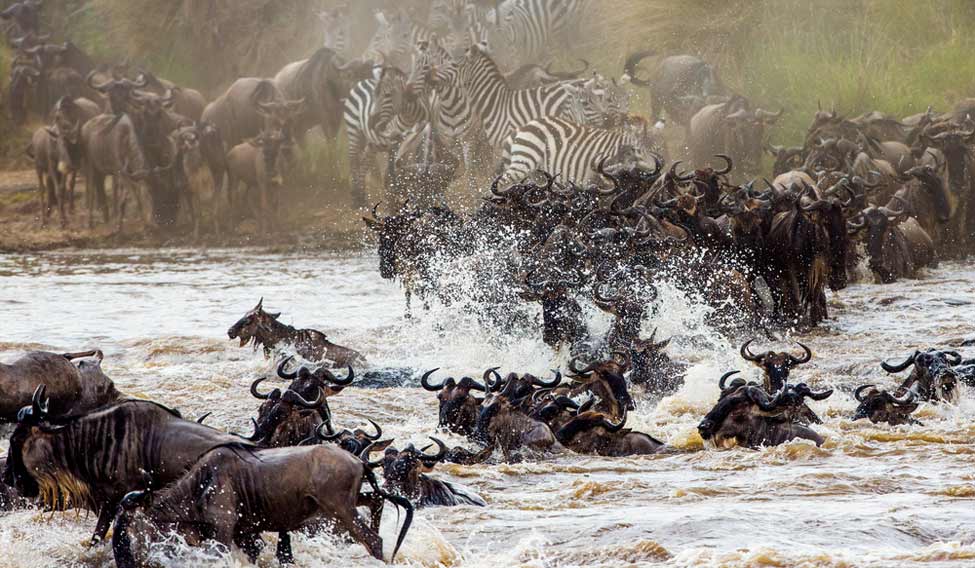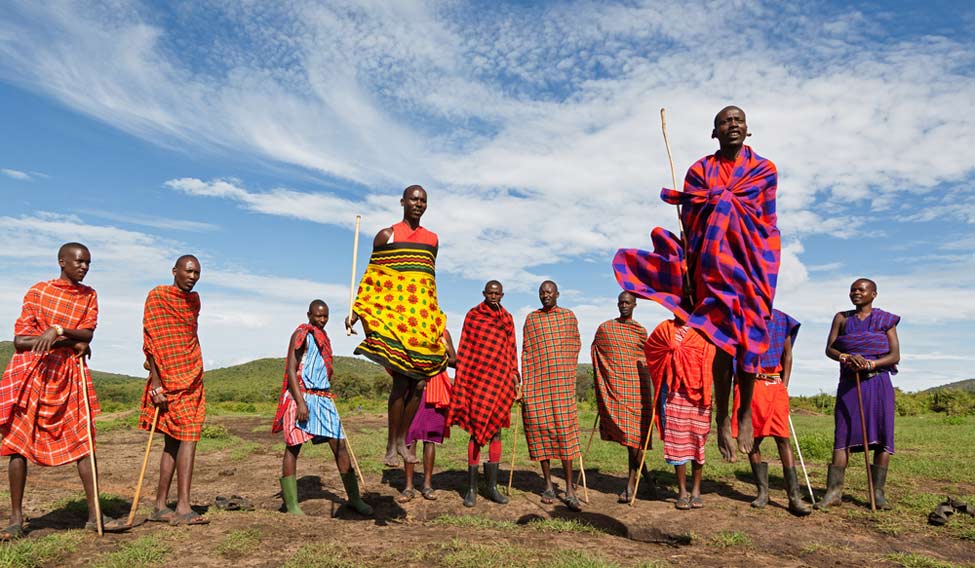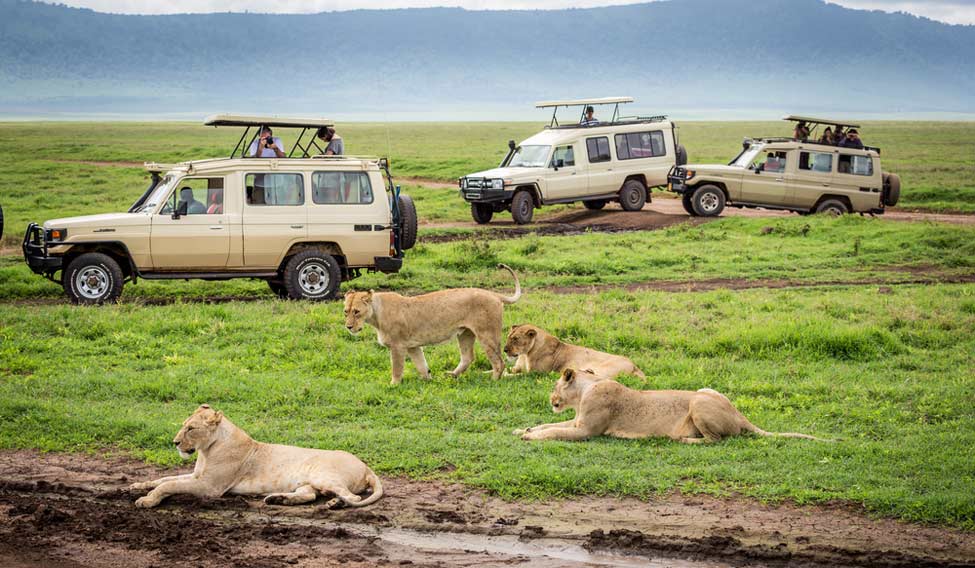Our minibus draws close to a lion and a lioness lounging in the savannas of the Masai Mara National Reserve. The lion turns his head and looks straight at us and I wonder what is going through his mind. He opens his mouth wide and yawns, leaving us in no doubt of his opinion of us. When the lioness moves a little way off, he follows her and lies on top. But she is in no mood to mate and roars him away, clearly proving who’s the boss between them. In another part of the reserve, a cheetah crouches, his sleek body tense and poised to pounce. Near him is a gourmet meal – an impala that, too, seems to be watching the cheetah. For a moment, everything is still. Then the impala makes a dash for it. The cheetah doesn’t follow and it looks like the game is over. But, to our surprise, the impala bounds back as though it has a death wish. “She has a baby somewhere near the cheetah which she is trying to save,” our guide, a Kenyan called Boniface Mbithi, explains to us. Some way off, one of the world’s greatest spectacles is underway – the Great Migration, in which more than two million wildebeest make their way from Tanzania to Masai Mara from July to October, along with thousands of zebras and Thomson’s gazelles. Although the migration is nearly ending, it is still a sight to behold. What is more breathtaking, we are told, is watching the “crossing” - hundreds and thousands of wildebeest crossing the Mara river. For long interminable seconds, they will hold back because they are terrified of water. Then the bravest of them will make a leap and all the others will follow, tumbling on top of each other. Many hit the rocks and break their legs. Others fall prey to crocodiles. Some of them who reach the other side without their calves will turn, despite their fear, to save their young ones. Thousands of wildebeest die during the crossing.
 Wildebeests cross the Mara river
Wildebeests cross the Mara river
Two days earlier, when we were on our way to Masai Mara, Boniface – a gentle man with a ready smile and a soft voice – told us to “get ready for an African massage”. His meaning became clear when I experienced one of the bumpiest rides of my life from Narok, which is the largest Masai village, to Sarova Game Lodge inside the reserve where we were staying. I imagined I could hear the bones in my body rattling with each dip and tilt of the vehicle. At Sarova, a quaint place with an appealing old world charm, we were shown to the luxury tent where we would be staying. The best thing about the lodge was the service. Kenyans are so friendly they will go out of their way to help you. No one will pass you by without a smile and a greeting. Jambo, asante sana and karibu (Words in Swahili for hello, thank you very much and welcome) were heard so often that they became fixtures in our memory. On the way, gap-toothed urchins with one thumb in their mouth will wave furiously. Women holding heavy pots will nod in acknowledgment. Men helming the numerous roadside car washes and vegetable stalls will look up and flash high voltage smiles. What Kenyans lack in wealth, they make up for in warmth.
Of course, the animals at the reserve showed us no such consideration. The reserve covers around 1,500 square kilometres in south west Kenya. Masai Mara is named after the Masai, or the traditional inhabitants of the region. ‘Mara’ means ‘spotted’, a fitting name for a landscape of open grassland spotted with lone Balanite trees and croton shrubs. The vast swathe of savannas is known for its resident population of leopards, lions, rhinos, cheetahs, buffalos, elephants, gazelles and topis. It is contiguous with the Serengeti Park in Tanzania to the south, from where the wildebeest migrate, although game drives between the two countries are not permitted. “Only the animals don’t need visas,” Boniface joked.
To watch the Thomson’s gazelles, the water bucks, the impalas and the topis serenely grazing on the grass is to feel a sense of peace. They live their lives roaming on the wild plains sleeping and eating, having no 10 year plans, no to-do lists, no targets to meet. Each animal has been created to serve a specific purpose designed to balance and sustain life. Zebras and wildebeest, for example, will always be seen walking together because the zebras prefer the long blades of grass and act as lawnmowers so that the wildebeest can graze on the flattened grass and shoots. Female impalas will always travel in harems with only one male guarding them. When the male becomes infirm, a healthy young bachelor will stake his claim to the harem, fighting the older one for it. The wildebeest have such a terrible memory that after running a short distance from a predator, they forget that they are being followed, making them easy prey to lions and leopards. Their high mortality is balanced by the fact that they breed in large numbers. A cheetah can run at a speed of 110 km per hour but only for 200 metres. If it doesn’t catch up to the prey in that distance it will give up because its body gets too overheated.
 Masai men jump as part of a traditional cultural ceremony in Masai Mara National Park | Vadim Petrakov
Masai men jump as part of a traditional cultural ceremony in Masai Mara National Park | Vadim Petrakov
Each animal has been created with specifications so exact that you’re forced to conclude that God must be a Being not just of great power but a vast imagination as well. Cheetahs, for example, use their tails as rudders to steer and change directions. Secretary birds have been so named because their strut reminds one of a no-nonsense secretary. An African elephant’s life span is determined by its teeth. After its sixth set of teeth falls out, the elephant retires to wet, marshy land where it feeds on soft plants. Then it dies of starvation. Hippos mark their territory using their excreta. A buffalo’s forehead is so strong that if you hit it with a bullet, you might give the animal a mild headache. Lions kill cubs that are not their own so lionesses, very smartly, mate with all the lions in a pride so that the lions get confused about who their cubs are. God must also have a sense of humour as he’s made the movement of the ugliest of animals – the wildebeest – the biggest attraction for hundreds and thousands of tourists every year.
On our last evening in Masai Mara, we went to a Masai village and was greeted with a welcome dance, which consists of Masai men in colourful red outfits called Ronkiny Onyokei hooting and jumping up and down. “In Masai, a man’s worth is judged by how high he can jump,” explains a Masai man called Joel. “The higher he jumps, the more women he wins.” Earlier, a Masai proved his manhood by going out to the bush and killing a lion but now it is prohibited. “If he didn’t kill a lion, he couldn’t get married,” Joel explains to us. “Now, a Masai has to spend three years in the bush, drinking blood and learning about herbal medicines.”
The Masai are a semi-nomadic, polygamous tribe numbering around 1 million, with their population increasing rapidly because of better healthcare and lower mortality. Although earlier they believed in a God of the atmosphere called Enkai, many of them have converted to Christianity as a result of the work of missionaries in the region. Now, the government gives incentives to educate the Masai and many speak excellent English. Dodging Masai girls selling bead jewellery, we make our way into the village, which is a large enclosure flanked by low-roofed huts made of cow dung and clay soil. The huts are very flimsy and made to last only for 10 years as the Masai are nomadic. Inside, it is dark, a small fire throwing shadows across the wall. (They sieve the ash from the fire and use it to cure whooping cough.) There is only a small opening in the back to let in fresh air. Even more disturbing is the fact that young goats, separated from their mothers, live inside the house with the family. The Masai depend on livestock for their livelihood. Cows are their currency. A Masai man, for example, has to give 15 cows to the family of the woman he wants to marry.
 Buffaloes at a pond in Masai Mara National Park
Buffaloes at a pond in Masai Mara National Park
With the Masai becoming educated they are taught the importance of wildlife conservation but they still take their cattle to graze in the reserve, destroying the natural habitat of the animals. “During droughts, the Masai have nowhere else to take their cattle so they go deeper and deeper into the reserve,” Boniface tells us. “Land-grabbing is rampant among them, with the more educated and the elite cheating the elders and the illiterate of their land. And the Masai are always asking for more financial support from the government. When they don’t get it, they fence off their land, which means the animals have less land to graze in.” Emmanuel Nkuyata, another Masai man, admits that they do take the cattle to graze within the reserve but denies that it is doing any harm. “Decades ago, during the time of our grandfathers, cows and wild animals used to co-exist without any problem,” he says. “Why should it be an issue now?”
Also worrying is the proliferation of lodges and settlements inside the reserve, each of which uses electric fencing to ward off the animals. The increasing number of tourists to Masai Mara is another threat to the animals. Vehicles are not allowed to go off the track but they frequently do so to get a closer look at the animals. Guides and drivers ignore ‘Rangers Only’ signposts that are meant to ward off encroaching vehicles and allow the grass to grow in certain areas of the reserve. “Earlier, there were so many trees in this region but now they have all been cut down for charcoal,” says Boniface. “The charcoal trade is thriving here. The increasing settlements are polluting the environment. When you go around, you see trash and bits of nylon paper all around. This is a great hazard to the animals which try to consume them and die.” Ray Ewing, the Canadian captain who took us on a hot air balloon to get an aerial view of the animals, says that five or six years ago, when he first came to Masai Mara, there were 32 rhinos in the reserve. Now their numbers have decreased to 20. “The number of lions are also coming down,” he tells us. “White rhinos have almost become extinct in the region.” According to a study published in the Journal of Zoology, the numbers of impala, warthog, giraffe and topi have declined by over 70 per cent in the last three decades. Numbers of cattle grazing in the reserve have increased by more than 1,100 per cent. Masai Mara without the animals will be a dark and barren place, like a scene from a dystopian novel. If we’re not careful, we might be barreling towards an ending that none of us will be able to rewrite.









